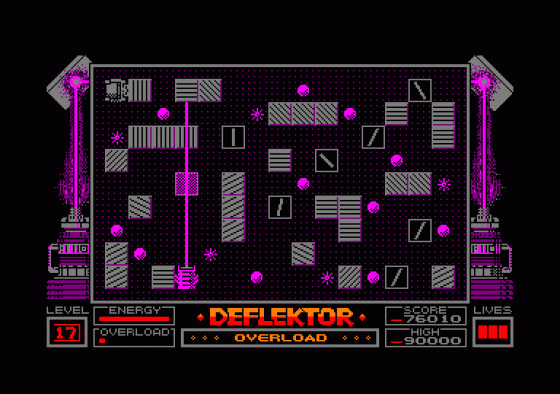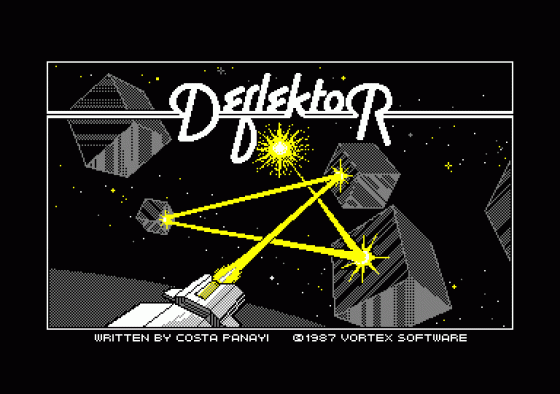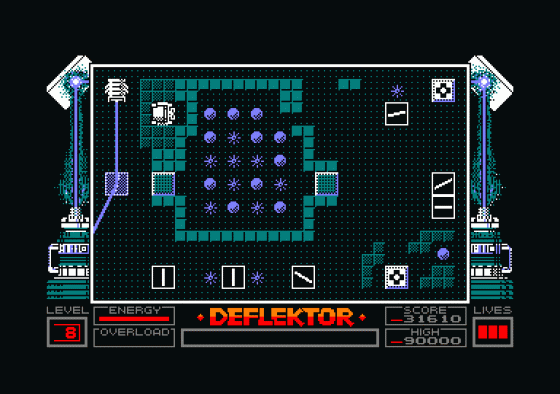
Amstrad Action
 1st March 1988
1st March 1988
Categories: Review: Software
Author: GBH
Publisher: Gremlin
Machine: Amstrad CPC464
Published in Amstrad Action #30
Vortex are famous for games like Highway Encounter, and Alien Highway, both programmed by Costa Panayi. So his latest venture, into the world of laser optics, was loaded with much interest. Particularly since this is the first Vortex title since they linked up with Gremlin.
The object of the game couldn't be simpler; all you have to do is destroy all the cells dotted around the screen with a laser, and then line the beam up on a receiver. The screens are made up of a mass of mirrors and obstacles that you have to guide the laser around, using a cursor to alter the position of mirrors that deflect the beam.
Completing the objective is made more difficult because of the various objects and their positioning on the screen. Cells are sometimes in what look to be inaccessible places and there are the gremlins that wander around getting on your nerves by moving your carefully-positioned mirrors.

On the screen, there is the playing area and a status panel. The playing area shows the position of your cursor, the laser beam and all of the objects that make up the level. The status panel shows the level, number of lives, laser energy, overload and score. You have three lives to complete each screen with and so you'll always get three chances at each level, even if you completed the previous one on your last life.
The laser energy is used up as time passes and if this runs out you lose a life. If the beam is too long, hits a mine or is reflected back along the path into the laser source then an overload situation occurs. When the overload meter is filled, you lose a life. If you move the beam in time, the overload will fall gradually back to zero.
There are several types of object that affect the beam in different ways: reflectors, refractors, mirrors, absorbers, polarisers and fibre optics. There are two types of mirrors: rotating and stationary. The stationary mirrors can have their angle turned through 360 degrees and the rotating mirror sends the beam out in lighthouse fashion. The rotating mirror can be stopped or rotated faster if necessary. Reflectors make up "walls" on screen and have similar properties to mirrors, but they can't be moved.

The beam is sent in random directions when it hits a refractor and often this is the only way to get some of the cells. If the beam strikes an absorber it stops there, naturally enough. There are two types of polarisers: reflectors and absorbers, both rotate continuously and allow the beam to pass through when the polariser is lined up correctly. The reflecting polariser bounces the beam off in the same way as a mirror when it can't pass through and the absorber stops the beam like the absorbing blocks. Pairs of fibre optics appear on some screens and when the beam enters one it leaves through the other travelling in the same direction as it entered the first.
Two other things appear on screen and neither is any good for you: gremlins and mines. Gremlins are interfering little busy bodies who wander around the screen turning mirrors around and generally being a nuisance. Just when you've got a long complicated route set up, a gremlin will come along and move a mirror, possibly causing a fatal catastophe. You can temporarily destroy them by moving the cursor over them and firing. Mines on the other hand don't move, but are more deadly because if the laser hits them it overloads very quickly.
Initially, the game seems easy, but the time limit soon becomes a serious problem with cells still on screen and the laser power diminishing rapidly. Higher levels have more complex arrangements of objects and Gremlins appear in larger numbers. There's a demo mode that shows you all 60 levels and some of them are very mean indeed. A practice mode lets you try three levels with no chance of overload and a much longer time to complete the level.

Sound is simple and limited, but it's good enough and a great tune plays on the title screen or during the intermission. The graphics are easily recognisable and colourful, the sort that you'd expect from Costa. Colour is not used much with only a few colours on screen at any one time, the overall impression is a little dull since the backgrounds are generally black.
Frustrating and addictive are two words that come to mind with this game. It's frustrating when you run out of time with the beam just one turn awway from the receiver and addictive because you'll be sure that you can do it next game. It may not appeal to everyone, but it's definitely worth a look at, it's even vaguely educational with it teaching you the principles of optics.
First Day Target Score
Complete 10 levels.
Second Opinion

It's great to see that Vortex and Consta Panayi have lost none of their flair and originality since teaming up with Gremlin. The game is a superb test of fast, logical thought. It has the same sort of mental difficulties attached as planning a series of moves in a chess game. However, unlike chess the results are immediate and spectacular. The levels do get a bit samey but the addiction doesn't stop. You'll end up like the features in the game - totally absorbed, with your vision polarized on the screen.
Green Screen View
It's duller, but just as playable.
The Verdict
Graphics 76% P. Clear and easily recognisable graphics. N. Not that much colour!

Sonics 64% P. Great title tune.
Grab Factor 93% P. You'll just *have* to complete one more level. P. Masterfully absorbing need for fast, strategic thought.
Staying Power 88% P. 60 levels will keep you going for a long time. P. Problems get more and more difficult as you progress.
Overall 90% An original concept, wonderfully implemented.













